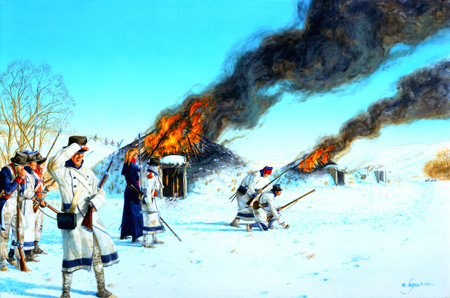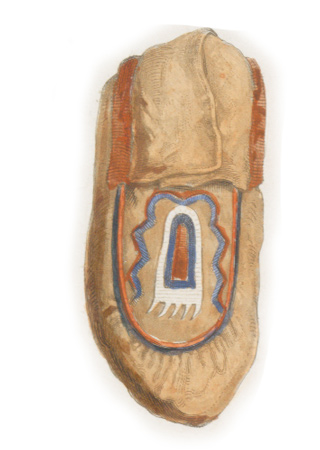Many miles south of Fort Mandan below the Knife River Villages, Lewis and his soldiers continue their pursuit of a Sioux war party. They come to an old Mandan village where two lodges have been set afire and their hunters’ cache of meat pillaged.
Snow Blind
by Yellowstone Public Radio[1]Originally aired weekdays by Yellowstone Public Radio during the Bicentennial observance of 2003-2006. Narrated by Hal Hansen. Scripts by Whit Hansen and Ed Jacobson. Produced by Leni Holliman. © … Continue reading
Smoking Lodges
We renewed our pursuit early, and had a cold morning. Having proceeded twelve miles we discovered fresh smoke arising at some old camps, where we had hid some meat before when Captain Clarke was down; and therefore advanced with caution.
—Patrick Gass
Sioux Moccasin with Bear Paw Design
Karl Bodmer (1809–1893)
Rare Book Division, The New York Public Library. “Indianische geräthschaften und waffen. Ustensiles et armes indiens. Indian utensils and arms.”[2]New York Public Library Digital Collections. Accessed February 22, 2019. http://digitalcollections.nypl.org/items/510d47da-c46b-a3d9-e040-e00a18064a99.
Scorched Earth
we came to the lodges, where we found that they had left place 24 hours before that, & had Set 2 of the largest lodges on fire which caused the Smoak. I then Sounded the horn the other party came up, we found they had tore down the meat pen which our men had built & left 2 Elk in it. they took the meat all away, except a fiew small peaces of buffaloe meat which they left in the small lodge which they broiled.
—John Ordway
Abandoned Moccasins
the Inds. who Commited the roberry of the 2 horses was So far a head that they could not be overtaken, they left a number of pars of Mockersons which, the Mandans knew to be Souix [Sioux] mockersons,—
—William Clark
Weather Diary
State of the Ther. at rise
Weather Wind at rise
Thermt. at 4 oCk. P.M. Weather Wind at 4 oCk. P.M. River 2 [above 0] fair S. E 8 [above 0] fair W fall 1 in. —William Clark[3]To assist the reader, the editor of this web page has omitted the date column, merged the “State of the River at
rise” columns, and spelled out some abbreviations.
Experience the Lewis and Clark Trail
The Lewis and Clark Trail Experience—our sister site at lewisandclark.travel—connects the world to people and places on the Lewis and Clark Trail.
Plan a trip related to February 16, 1805:

Fort Mandan is a High Potential Historic Site along the Lewis and Clark National Historic Trail managed by the U.S. National Park Service. The North Dakota Department of Parks and Recreation manages a modern reconstruction and the Lewis and Clark Interpretive Center located at US Hwy 83 and ND Hwy 200A.
Knife River Indian Villages National Historic Site is a High Potential Historic Site along the Lewis and Clark National Historic Trail managed by the U.S. National Park Service. A unit of the National Park System, the site is located at 564 County Road 37, one-half mile north of Stanton, North Dakota. It has exhibits, trails, and a visitor center.
Notes
| ↑1 | Originally aired weekdays by Yellowstone Public Radio during the Bicentennial observance of 2003-2006. Narrated by Hal Hansen. Scripts by Whit Hansen and Ed Jacobson. Produced by Leni Holliman. © 2003 by Yellowstone Public Radio. |
|---|---|
| ↑2 | New York Public Library Digital Collections. Accessed February 22, 2019. http://digitalcollections.nypl.org/items/510d47da-c46b-a3d9-e040-e00a18064a99. |
| ↑3 | To assist the reader, the editor of this web page has omitted the date column, merged the “State of the River at  rise” columns, and spelled out some abbreviations. rise” columns, and spelled out some abbreviations. |




